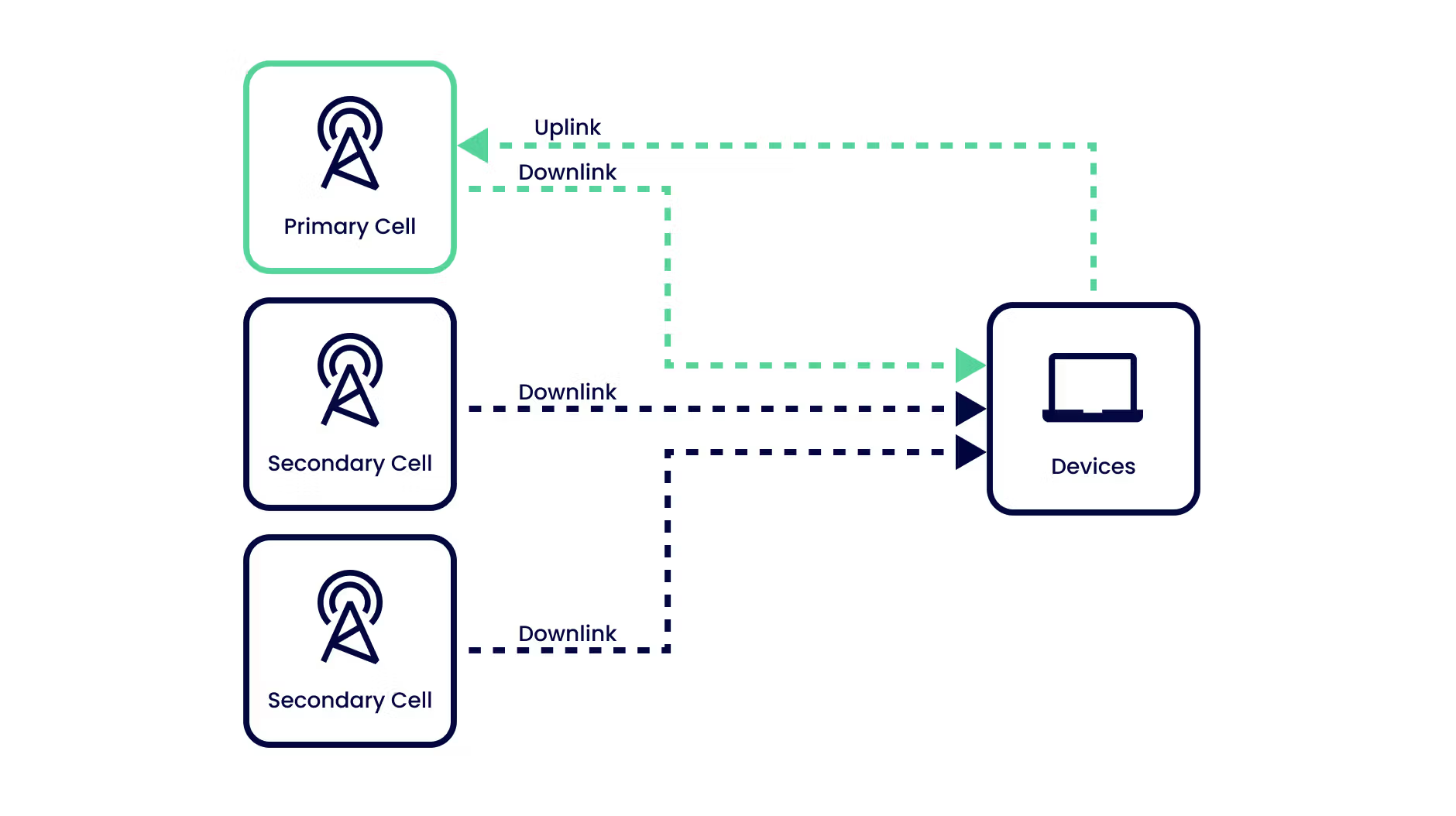Also in this category
View more in 5G5G
What is 3-Component Carrier Aggregation (3CC) in 5G?
Updated on July 9, 2025

Demand for faster, more reliable mobile data has been a part of the digital landscape since wireless communications first emerged. Today, bandwidth-intensive applications like high-definition video streaming, virtual reality (VR), cloud-native applications, and real-time industrial automation are pushing the performance limits of mobile networks like never before. These applications create an unprecedented demand to move data faster and more reliably, necessitating continuous advancements in wireless communication.
Carrier Aggregation (CA) is a foundational technology that combines multiple data channels, or component carriers (CCs), into a single, wider logical channel, allowing for significantly faster data transfer. The latest iteration of this technology, 3 Component Carrier Aggregation (3CC) in 5G, directly responds to the escalating demand for higher data rates because of limitations of modulation and coding technology.
By combining three frequency bands for dynamic traffic aggregation and management, 3CC enables service providers to adjust and optimize network capacity and performance. Combined with industry-leading 5G cellular connectivity, 3CC offers an unprecedented ability for service providers to meet enterprise demands for network performance and flexibility.

How does 3CC optimize the capabilities of 5G?
Beyond simply improving performance, 3CC helps unlock unique capabilities in 5G networks, while also benefiting from 5G’s advanced capabilities.
For one thing, the technology plays a crucial role in 5G Standalone (SA) deployments. By combining FDD low-bands, which offer wide coverage, with TDD mid-bands, which provide a balance of coverage and capacity, 3CC simultaneously optimizes both throughput and geographical reach. Its flexible and customizable structure, where one Primary Component Carrier (PCC) handles the main data traffic and signaling while up to two Secondary Component Carriers (SCCs) can be added as needed, allows the network to adapt in real time and maintain a high Quality of Experience (QoE) for users. Intelligent bandwidth allocation based on network demand and signal conditions optimizes resource utilization.
5G New Radio (NR) has greatly advanced the use of Carrier Aggregation. Introduced in 3GPP Release 15, 5G NR supports up to 16 configured Component Carriers for both downlink and uplink. These CCs can vary widely in bandwidth, ranging from as little as 5 MHz in Frequency Range 1 (FR1) to up to 400 MHz in Frequency Range 2 (FR2). They can also use different duplexing methods (FDD or TDD), enabling overall transmission bandwidths of up to 6.4 GHz.
Importantly, CA is implemented as software functionality in both Radio Access Networks and user devices, allowing for flexibility, dynamic resource allocation, and rapid deployment of new features without the need for extensive hardware upgrades.
How 3CC optimizes network resource use
3CC technology in 5G networks doesn't just make things better for users; it significantly boosts how efficiently networks operate.
Enhanced performance and responsiveness
3CC enables multi-gigabit performance, with user data rates reaching approximately 4 Gbps and even higher. This is crucial for applications that demand a lot of bandwidth. By combining multiple carriers, it also drastically shortens response times. This low latency is essential for real-time and mission-critical applications like remote surgery and autonomous vehicles, where every millisecond counts.
Optimized spectrum utilization and capacity
Aggregating underutilized bands with busier ones maximizes the use of available spectrum. This increases overall network capacity and can even reduce the need for expensive new cell site deployments. This not only improves performance but also leads to operational savings for network operators. Similarly, by combining high-capacity, short-range bands with longer-range, low-frequency ones, networks can extend coverage more effectively, giving users more consistent and reliable service. Better coverage can also mean longer battery life for devices, as they don't have to work as hard to maintain a connection.
Energy efficiency and future foundation
By maximizing throughput while using fewer resources, networks operate much more efficiently. Energy efficiency is now a core design goal for the mobile industry, with a target of net-zero carbon emissions by 2050, and 3CC improvements align perfectly with this goal. As the industry moves towards next-generation applications and critical infrastructure, 3CC provides a strong foundation. While faster speeds are often highlighted, the reduced latency and enhanced coverage are especially vital for new industrial and societal applications. Innovations like remote surgery, autonomous vehicles, smart electric vehicles, humanoid robots, and advanced cloud-native mobile phones all benefit from the robust and flexible infrastructure that 3CC provides.
Deploy 3CC 5G today with Inseego
We offer 3CC-capable devices, allowing businesses to immediately take advantage of their advanced capabilities.
The Inseego Wavemaker FX4100 5G cellular router exemplifies the practical application of advanced Carrier Aggregation. This router supports 5G Standalone (SA) and Non-Standalone (NSA) modes, offering uplink aggregation with 2 Component Carriers (2CA) and 3 Component Carriers (3CA) for downlink. This capability enables not only faster download speeds but also enhanced upload performance, which is crucial for applications such as video conferencing and real-time analytics.
Learn more about how Inseego devices can help your business take advantage of 3CC for next-generation capabilities
Talk to our experts!
Set your customers or business up with the fastest, most secure, easiest, most reliable fixed wireless solutions.
